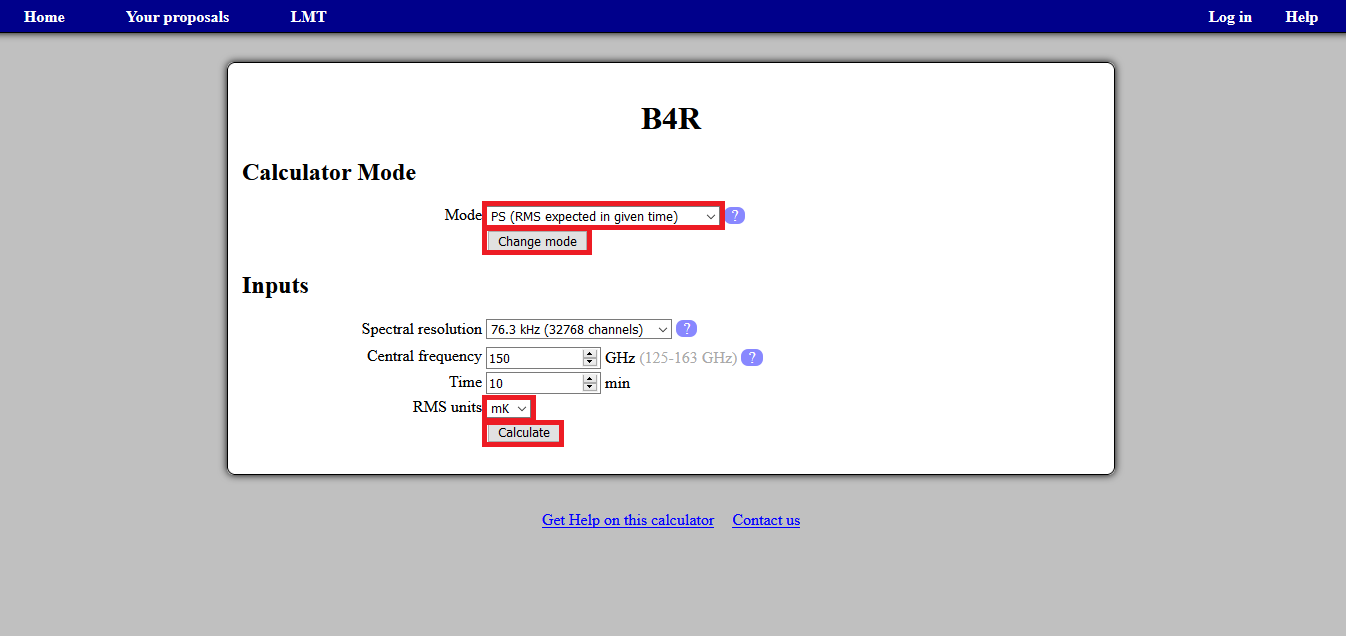B4R Sensitivity/Integration Time Calculator
This calculator can be used to estimate sensitivity or integration times for the Band 4 Receiver B4R on the 50-m LMT.
Receiver
The B4R is the receiver system which consists of 2 mm receiver and a dedicated digital spectrometer composed of four XFFTS boards. The 2mm receiver is a single-beam two-polarization receiver which is based on ALMA band-4 “2SB” (two-polarization sideband-separating) mixer (Asayama et al. 2014, PASJ, 66, 57). It was re-designed for the LMT and for the use of two stage Sumitomo GM 4K cryocooler. The optics of the B4R is designed to fully use the 50 m diameter of the LMT with an edge level of – 12 dB.
The B4R was installed and commissioned in 2018, and demonstration science observations were performed in Autumn 2019. During the commissioning and science observations, it was confirmed that the B4R on the LMT meets the basic ALMA specifications, and the beam size was measured to be about 10 arcsec in FWHM and the aperture efficiency was 46±6 % at 147 GHz. The typical system noise temperature, Tsys, was 100 K during the observations. Both position switching mode (PS; e.g., for high-z CO line detections and spectral scan observations) and On-the-Fly mapping (OTF; for wide area spectral line mapping covering, e.g., 10 arcmin x 10 arcmin.) are available using the B4R.
Calculation Modes
NOTE: The “Input parameters” section provides a description of each parameter required by the calculators.
The B4R calculator allows to choose between two different observing modes: 1) Position Switching (PS) Mode for pointed observations and 2) Map Mode designed for mapping extended regions of the sky. As described below, both calculators can be used to estimate the “RMS expected in given time” and the “Time required for target RMS”.
Position Switching (PS) Mode:
- RMS expected in given time: choose the spectral mode and provide your desired integration time in minutes. Press the ‘Calculate’ button to determine the sensitivity in the selected units (mK or mJy).
- Time required for target RMS: choose the spectral mode and provide your desired sensitivity (in order to change units press the ‘Units’ button and select between mK or mJy). Press the ‘Calculate’ button to determine the required integration time.
Map Mode:
Choose the spectral mode. Provide the central frequency in GHz and the size of the desired map in arcsec.
- RMS expected in given time: provide the desired integration time (in minutes) and press the ‘Calculate’ button to determine the sensitivity in the selected units (mK or mJy).
- Time required for target RMS: provide the desired sensitivity (in order to change units press the ‘Units’ button and select between mK or mJy). Press the ‘Calculate’ button to determine the required integration time.

For the Map Mode calculator, the spectral mode, central frequency and map size will define the time required to make a single map and its corresponding depth. The total time or final RMS is estimated in multiples (integer) of single map realizations. If the total time or final RMS required does not correspond to an integer number of maps, the calculator outputs the nearest options (rounded up). For reference, the calculator also outputs the required time to complete one single map and its expected depth.
If a project requires different transition lines to be targeted (and which do not fall within a single band width), integration times must be estimated for each transition and added to estimate the total time to be requested in the proposal.
You can find a description of the instrument in the B4R
Input parameters
B4R spectrometer can operate in three different spectral modes, which define the spectral band width and number of channels. The user will have to select between these three available Spectral Modes.
Central frequency [GHz] of your expected line, between 125 - 163 GHz
MAPX [arcsec]: Desired map size in the X direction (must be >=60 arcsec)
MAPY [arcsec]: Desired map size in the Y direction (must be >=60 arcsec)
TIME [min]: where the user gives a desired RMS to be reached and the required time is calculated.
RMS [mK or mJy]: where the user gives a proposed integration time and the corresponding RMS is estimated.